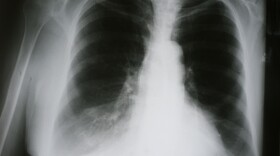In Tarrant County, patients with severe chronic obstructive pulmonary disease, COPD, now have access to a procedure that can lessen airflow blockage and improve their quality of life.
KERA’s Sam Baker talks about endobronchial valves with Dr. Sai Karan Vamsi Guda, an interventional pulmonologist with Texas Health Fort Worth.
Tell me about life for patients with severe COPD or emphysema.
Patients who have emphysema usually speak really rapidly, or they cut short their words or sentences and break it down. And then in the middle, they take deep breaths. They can't speak in full sentences.
In other patients, they are unable to climb up a flight of stairs or if they have grandchildren, play with their grandchildren or their pets.
They are unable to stand for long times in the kitchen to do the cooking or pick up a load of laundry that they have just done, and their quality of life deteriorates day by day because emphysema is a progressive disease.
So, what are endobronchial valves and how do they work?
In emphysema patients, because of smoking or in certain genetic disorders, the airways or the alveolar, the sponge part of the lung, essentially balloons open and takes over the real estate of the lung.
These endobronchial valves allow air to come out of those areas that are hyperinflated, thereby improving the mechanics of your breathing, improving the position of your diaphragm.
So when you try to take a deep breath in, you actually can and you're not restricted by the anatomy of your body.
How would you install an endobronchial valve?
We use a small catheter. It's about three millimeters in size. We go in through the bronchoscope, and up to the area that we want to treat or that should be treated. And then we deploy the valves bronchoscopically.
There is very minimal bleeding involved. There is no cutting involved in this scenario at all.
The valves treat severe COPD or emphysema. But do they cure it?
They do not. To clarify, the valves treat hyperinflation, which causes the degree of diminished quality of life from the patients, thereby improving their quality of life.
It treats the hyperinflation component of emphysema more than anything else. Then, the patients benefit from all the other aspects of COPD because of the end of bronchial valves.
But then you'd have to do what after having these valves installed?
So once the valves are installed you still take your inhalers. But until this technology was available about seven to eight years ago in the United States, the only options patients had were inhalers, nebulizers, breathing treatments, steroids, transplants, and oxygen, of course.
These are the backbone of the patients’ management of their emphysema, but they can be a lot more effective because the patient can actually breathe.
What can you expect in quality of life after that?
Over the first six weeks, it's going to be a gradual improvement or an expected improvement in their quality of life. Something very small, but one of my patients told me "I couldn't bend down before" because your lungs are so big that you just can't bend down without losing your breath. And now she said, "I can bend down and tie my shoes. I had to get Velcro shoes, but now I can use the shoes that I had before. I could tie my laces."
In our mind, we don't think of that as great quite like that. How does that make sense? But it does make sense from a physiological standpoint, from a mechanic standpoint.
When it comes to expectations, the patients who do meet the criteria go through all the testing, get the bronchial valves, and go to pulmonary rehabilitation. With the medications, staying away from cigarettes and other forms of tobacco, inhaled vaping, and all of those things, they can expect an improvement in their quality of life for up to two years. I mean, that is significant.
RESOURCES:
Endobronchial Valve (EBV) Therapy
Endobronchial Valves for the Treatment of Advanced Emphysema





